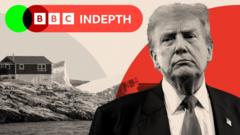Greenland's population is grappling with their national identity amid a history of Danish colonialism and emerging U.S. ambitions. While most Greenlanders express a desire for independence, they also wish to maintain essential welfare benefits, complicating prospects for their future autonomy.
Greenland's Struggle for Identity: Independence or American Influence?

Greenland's Struggle for Identity: Independence or American Influence?
As Greenland confronts its colonial past and modern pressures, the desire for autonomy from Denmark clashes with new interests from the United States, particularly under Donald Trump’s administration.
On a scenic hill overlooking Nuuk, a poignant statue of Hans Egede stands, symbolizing Denmark’s long-standing impact on Greenland. Egede, a 18th-century missionary, is credited with reconnecting Greenland to Northern Europe, a move that laid the groundwork for Denmark's colonial legacy. As a child in Greenland during the late 1970s, I witnessed first-hand the divided sentiments among the Inuit population regarding foreign influence, particularly as the country navigated its identity amidst modern improvements like education and healthcare, juxtaposed against social issues like alcoholism.
Fast forward to today, Greenland is engaged in a renewed debate about its future, particularly in light of comments from former President Donald Trump regarding the territory's strategic value to the United States. In a controversial statement, Trump dismissed the notion of ruling out military or economic force, claiming practical needs for economic security. Danish Prime Minister Mette Frederiksen's firm declaration that "Greenland belongs to the Greenlanders" further exemplifies the growing tension.
Polls suggest that only a small percentage of Greenlanders support American annexation, revealing widespread resistance to losing their autonomy. As Greenland grapples with painful memories from the past—like forced contraceptive policies and child adoptions—conversations around independence are reigniting among leaders and citizens. Just as in past decades, when the island sought an identity beyond Danish colonialism, the desire for self-determination now resonates strongly among its population.
A striking 67% of Greenlanders express a desire for independence, but this comes with caveats. Many worry about the potential loss of welfare benefits currently provided by Denmark. Recent discussions have surfaced, suggesting that independence would require significant economic restructuring, incorporating new models of partnership with other nations to ensure stability without Danish support.
As geopolitical dynamics shift, Greenlanders are also contemplating alternatives to their historical ties with Denmark—potentially seeking relations with Canada and Iceland instead. The aspiration for a "free association" arrangement, paralleling models seen in the Pacific, emphasizes their quest for greater control and autonomy while pursuing meaningful partnerships.
With a population facing historical trauma yet exploring modern realities, the narrative of Greenland is constantly evolving. Its future independence hinges on the delicate balance between embracing autonomy and safeguarding the welfare provisions that have long defined its social structure. Both local voices and international ambitions will undoubtedly shape the path ahead as Greenland challenges the legacies of the past.






















